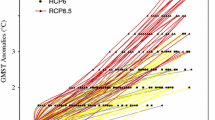Abstract
Global climate change will impact the hydrologic cycle by increasing the capacity of the atmosphere to hold moisture. Anticipated impacts are generally increased evaporation at low latitudes and increased precipitation at middle and high latitudes. General Circulation Models (GCMs) used to simulate climate disagree on whether the U.S. as a whole and its constituent regions will receive more or less precipitation as global warming occurs. The impacts on specific regions will depend on changes in weather patterns and are certain to be complex. Here we apply the suite of 12 potential climate change scenarios, previously described in Part 1, to the Hydrologic Unit Model of the United States (HUMUS) to simulate water supply in the conterminous United States in reference to a baseline scenario. We examine the sufficiency of this water supply to meet changing demands of irrigated agriculture. The changes in water supply driven by changes in climate will likely be most consequential in the semi-arid western parts of the country where water yield is currently scarce and the resource is intensively managed. Changes of greater than ±50% with respect to present day water yield are projected in parts of the Midwest and Southwest U.S. Interannual variability in the water supply is likely to increase where conditions become drier and to decrease under wetter conditions.
Similar content being viewed by others
References
Alcamo, J., Henrichs, T. and Rosch, T.: 2000, ‘World Water in 2025: Global modeling and scenario analysis for the World Water Commission on Water for the 21st Century’, Kassel World Water Series, Report Number 2, Center for Environmental Systems Research, University of Kassel.
Allen, R. G., Gichuki, F. N. and Rosenzweig, C.: 1991, ‘CO2 induced climatic changes and irrigation water requirements’, J. Water Resources Plann. Manage. 117(2), 157–178.
Arnold, J. G., Srinivasan, R., Muttiah, R. S. and Williams, J. R.: 1998, ‘Large area hydrologic modeling and assessment, Part 1: Model development’, J. Am. Water Resources Assoc. 34, 1–17.
Arnold, J. G., Srinivasan, R., Muttiah, R. S. and Allen, P. M.: 1999, ‘Continental scale simulation of the hydrologic balance’, J. Am. Water Resources Assoc. 35, 1037–1051.
Brown, R. A. and Rosenberg, N. J.: 1997, ‘Sensitivity of crop yield and water use to change in a range of climatic factors and CO2 concentrations: A simulation study applying EPIC to the central USA’, Agric. Forest Meteorol. 83, 171–203.
Gleick, P. H.: 1990, ‘Vulnerability of Water Systems’, in Waggoner, P. E. (ed.), Climate Change and U. S. Water Resources, Chapter 10, Wiley Interscience, New York, pp. 223–240.
Gleick, P. H., Adams, D. B., Busalacchi, A. J., Frederick, K. D., Georgakakos, A. P., Hayden, B. P., Jacobs, K. L., Meyer, J. L., Sale, M. J., Schaake, J. C., Seacrest, S. S., Kuzelka, R. and Stakhiv, E. Z.: 2000, Water: The Potential Consequences of Climate Variability and Change for the Water Resources of the United States, US Global Change Research Program, 151 pp.
Kirshen, P. H. and Fennessey, N. M.: 1995, ‘Possible climate change impacts on water supply of metropolitan Boston’, J. Water Resources Plann. Manage. 121(1), 61–70.
Lettenmaier, D. P., Wood, A. W., Palmer, R. N., Wood, E. F. and Stakhiv, E. Z.: 1999, ‘Water resources implications of global warming: A U.S. regional perspective’, Climatic Change 43, 537–579.
Miller, J. R. and Russell, G. L.: 1992, ‘The impact of global warming on river runoff’, J. Geophys. Res. 97(D3), 2757–2764.
Rosenberg, N. J., Epstein, D. J., Wang, D., Vail, L., Srinivasan, R. and Arnold, J. G.: 1999, ‘Possible impacts of global warming on the hydrology of the Ogallala aquifer region’, Climatic Change 42, 677–692.
Solley, W. B., Pierce, R. R. and Perlman, H. A.: 1998, Estimated Use of Water in the United States in 1995, U.S. Geological Survey Circular 1200, 71 pp.
Srinivasan, R., Arnold, J. G., Muttiah, R. S., Walker, C. and Dyke, P. T.: 1993, ‘Hydrologic Unit Model for the United States (HUMUS)’, in Advances in Hydroscience and Engineering, CCHE, School of Engineering, University of Mississippi, Oxford, MS.
United States Geological Survey (USGS): 1987, Hydrologic Unit Maps, US Government Printing Office, Washington, DC.
Wolock, D. M. and Hornberger, G. M.: 1991, ‘Hydrological effects of changes in levels of atmospheric carbon dioxide’,J. Forecast. 10, 105–116.
D. M.Wolock, G. J.McCabe.:1999, ‘Simulated effects of climate change on mean annual runoff in the conterminous United States’, Proceedings: Specialty Conference on Potential Consequences of Climate Variability and Change to Water Resources of the United States, May 1999, American Water Resources Association, Atlanta, GA.
Author information
Authors and Affiliations
Corresponding author
Rights and permissions
About this article
Cite this article
Thomson, A.M., Brown, R.A., Rosenberg, N.J. et al. Climate Change Impacts for the Conterminous USA: An Integrated Assessment. Climatic Change 69, 67–88 (2005). https://doi.org/10.1007/s10584-005-3610-y
Received:
Revised:
Issue Date:
DOI: https://doi.org/10.1007/s10584-005-3610-y




